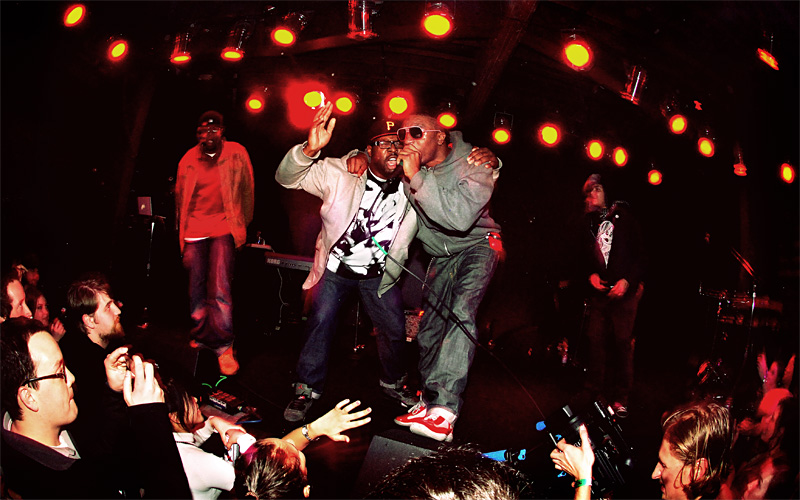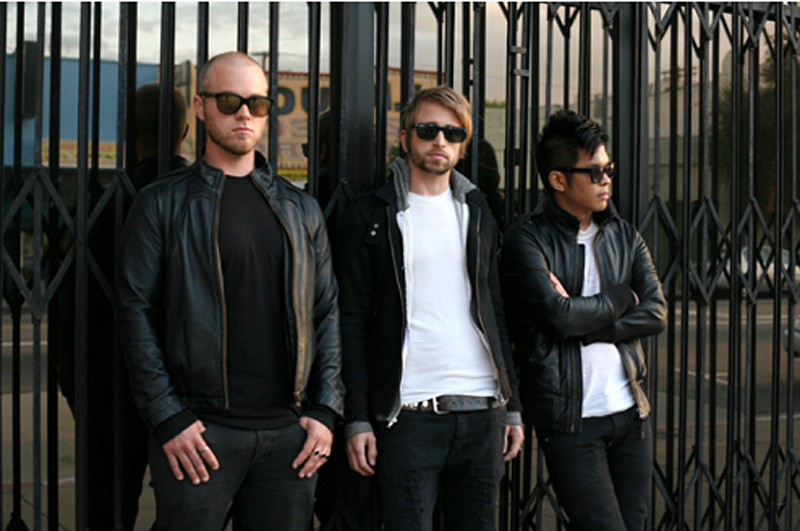Recently, members of some of Seattle’s most prominent hip-hop groups were all walking down Broadway when they happened to run into one another.
“It became a Go! Machine reunion,” says P Smoov, a rapper/producer with Mad Rad and Fresh Espresso, referring to the two-night local hip-hop showcase in early December at the Croc. Those concerts were considered by many a capstone of a stellar year in local rhyme-slinging and beat-making, and all those meeting P Smoov in that random encounter—Stasia Irons and Catherine Harris-White of THEESatisfaction and Gatsby of They Live!, among others—were featured prominently in both the Go! Machine concerts and the overall buzz generated by the scene last year.
Walking along Broadway, the friends started singing the chorus to “Posse on Broadway,” a 1988 song by Seattle’s Sir Mix-A-Lot, as they headed to the bar for a few drinks. Twenty years later, the man behind “Baby Got Back” still stands as the city’s only rapper to earn national recognition.
If you were at the Go! Machine shows and saw Macklemore’s impassioned delivery or Fatal Lucciauno convert pacifistic hipsters with his street sounds, then you’re probably wondering: What will it take for this scene to earn a country-wide audience on a par with those of, say, Atlanta or St. Louis?
After all, we’ve got the producers, the recording studios, the MCs, the venues, an endless supply of traveling acts, and a solid local and regional fan base on which to build. And after massively successful events like Go! Machine, it can be tempting to believe that Seattle’s hip-hop scene is playing at a higher level than it actually is.
Says Blue Scholars manager Dave Meinert: “There’s a lot of local hype that never amounts to anything outside of Seattle.” As a result, “Seattle is great at breeding mediocrity.”
The city’s hip-hop scene, long home to a multitude of sounds and styles, saw the emergence in 2009 of something bordering on a cohesive aesthetic: fun-loving, often spaced-out and danceable grooves that would seem to provide those outside Seattle with something to latch onto—a flare in the sky to guide them.
Not necessarily, say several scene veterans. “Anybody putting in work and making some noise out of Seattle is good for all of us, bottom line, no matter what type of sound they have,” says local rapper and promoter Candidt, adding “I don’t think it’s good for us to be pegged [to one sound].”
KUBE 93 DJ B-Mello puts it this way: “Right now, people might say there’s a hipster sound happening. But I think those things are passing.”
What isn’t passing is the need for local acts to build on the energy created this year by touring the country. In a joint response to e-mailed questions, THEESatisfaction’s Irons and her girlfriend/bandmate Harris-White write that if local artists want national cred, they need “to leave Seattle and work with artists from outside the Northwest area. The bills for shows are beginning to repeat themselves.”
Mad Rad hit the road DIY-style in 2009, and is headed back out this year (as is THEESatisfaction). This time, however, besides professionalizing their game on the back end, Mad Rad is also hoping to launch a tour showcasing other local acts—in the spirit of the rising tide that lifts all boats, says P Smoov. If this happens, it could go a long way toward increasing the visibility of Seattle hip-hop in general.
Local label Sportn’ Life Records has been one of the better outfits in recent memory at getting its people exposure beyond the Northwest. D.Black’s album Ali’Yah, for example, was released nationally, as was his video for the single “Yesterday.” As a result, says label honcho DeVon Manier, D.Black was able to land a slot at this year’s South by Southwest festival in Austin, among other things.
But even with such milestones, Manier says there’s still much more work to be done. “[National] booking agents would be a great help,” he says. “That’s what we’re dealing with right now. They look at things in the big picture—you have to be a reasonable size. And we’re not there yet.”
“Not there yet”: Those three words could also describe Seattle hip-hop as a whole. There’s something bubbling in the rookeries, to be sure, and acts like the Blue Scholars and Grayskul have been reaching out and touching folks well beyond the city limits for some time. But there are gaps in the lines waiting to be filled—and everyone has a different opinion, each valid in its own way, about what those might be.
“The talent isn’t the issue—it’s the infrastructure,” says Seattle native G. Prez of Presidential Media Group. “How many booking agents are in Seattle? What about a publicist? Where is the record label?”
Indeed, unlike the grunge movement, which had Sub Pop as its epicenter, Seattle hip-hop doesn’t have a label to anchor it. Nor does it have a CBGB-style venue a la New York’s punk scene. Rappers and DJs rock shows all over the city, from Fremont’s Nectar to Belltown’s Rendezvous. This isn’t a bad thing, but it does tend to disperse focus.
Says Prez: “It’s a lack of the other accessories that bring about exposure” that are hurting local hip-hop’s national potential.
Others see it as an MTV thing. “It’s basically [that] we don’t have any videos being picked to play,” says Candidt. On the main, this is true, but there are acts getting play on MTV’s various affiliates, including, most recently, Fresh Espresso’s “Big or Small.”
But Kitty Wu, board member of hip-hop advocacy organization 206 Zulu, has a different take: “Why do we have to have people watching our videos from outside our region?”
That’s a funny question coming from her, since she manages Khingz and does PR for Shabazz Palaces, generally considered the main contender for a national coming-out party. (Indeed, back in the day, as a member of seminal trio Digable Planets, Shabazz’s lone MC, Ishmael Butler, experienced just that kind of party, complete with a Grammy.)
This is a creative town, especially when it comes to music, and the city puts its money where its mouth is via a cornucopia of outlets, from two alt-weeklies to Easy Street Records to the sainted KEXP 90.3. Because of all this, it’s easy to get excited about stuff and blow it up into something bigger than it actually is—yet, anyway.
That the city is so supportive of the scene can backfire for artists, because ultimately it’s up to them to continue to push themselves artistically and promotionally. If you’re Mad Rad or Macklemore, both of whom had their way with the Croc’s stage during Go! Machine, the potential to cocoon yourself in local love and not march forward is strong.
As Meinert puts it, “You can be big in Seattle but not be great.” And, he adds, “You’re never gonna make it without being great.”
There was plenty of promising, if not great, hip-hop dropped last year, among them several EPs: The Physics’ High Society, Dyme Def’s Panic, and Grynch’s Chemistry. And this year holds even more promise, with the long-awaited solo debut from JFK (of Grayskul) and possibly a new Mad Rad album.
At this point, we could provide a grocery list of things folks need to do to bring more attention to Seattle hip-hop: get videos aired on MTV and its affiliates, tour the country regularly—basic stuff that most acts worth their weight in records already understand.
But in taking the long view of the scene, particularly of 2009’s new crop of artists, perhaps the most useful observation comes from locally based producer Jake One, who works with national acts such asw Freeway and Mayor Hawthorne: “They just gotta keep the momentum going. There’s a thousand other scenes doing the same shit. At a certain point, there’s a luck factor.”







